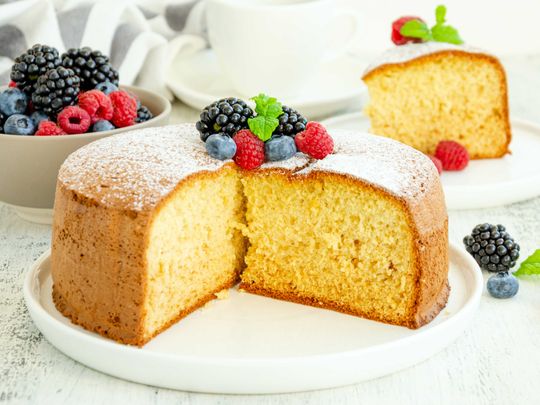
Winter rain is pattering down. Wild flowers are blooming in the desert and UAE residents are in holiday mode. Thanksgiving is just over and baking season is in full swing. With that comes a tray full of woes – collapsed cakes, dry cakes, mushy cakes, hard cakes… the list is endless.
Let me try and help you navigate the art of baking so the aroma of joy fills your kitchens this festive season.
Baking a cake perfectly is a science. Many factors affect the outcome of a baked cake and once you understand those factors along with the effect each ingredient and process has on the final product, the chances of you baking a cake perfectly increases with time, exponentially. This not only makes you a confident but also a happy baker.
Common cake faults
Before I share my ‘7 fool proof tips’ that will lead to a cake baked to perfection, you must know what are the various faults in cake making, how to identify them correctly, and the reason behind why they might occur. Here’s a little theory, so bear with me.
Curdled batter
This is when your batter looks similar to curdled milk.
It may occur due to the ingredients being at different temperatures or if all the eggs are added together or too fast before the cake batter has had the time to incorporate them. Don’t fret. It is not a crisis. It will work its way.
Cracked top
The cracking to cake tops is one of the most common cake faults. A cracked top might be preferred on tea cakes or travel cakes but not on a sponge cake that might be further frosted or decorated.
This generally happens if the oven temperature is much higher than what is mentioned in the recipe or if the raising agent is much more than what is required. Also every oven tends to have a bit of a personality of its own. So, although it might show the same temperature as the recipe, in some parts of the oven it might be hotter, causing the exterior to cook faster and the inner parts slower, which then leads to the cake cracking. A quick tip – start at a lower temperature and bake a bit longer – patience is key.
Low volume cake
This is when the cake doesn’t have the volume it should have and/or becomes too dense.
This generally happens in egg-based cakes, if the eggs are not whipped properly or if the other ingredients are not folded in gently causing the eggs to deflate.
Collapsed cake
M Fault – This is when the cake sinks from the centre while the sides have risen perfectly giving the cake an ‘M’ like appearance. It happens when either the oven is opened too soon or the quantity of raising agent is too high.
X Fault - This is the most frequent problems faced by bakers where the cake rises in the centre and the sides do not. It may occur due to high baking temperature or because of more liquid in the batter than what was required.
Sunken fruits
As the name indicates, in this cake fault, the fruits aren’t dispersed in the cake, but rather sink to the bottom of the cake.
This generally happens in oil based cakes which are thinner in consistency or the fruits are too dry making them heavier than the batter, hence falling to the base of the cake.
Cake baking tips
Now that you have a better understanding of what are the cake problems a baker could face and the reasons why they occur, here are a few of my tips to bake the perfect cake.
1) Always practice Mise-en-place
This step is of utmost importance for every recipe that you want to follow. The literal translation of Mise-en-place is ‘putting in place’ and that’s exactly what it means in baking.
This encompasses everything from reading the recipe thoroughly to measuring and placing ingredients required in separate bowls, along with choosing the correct bakeware and greasing/lining it.
It also includes preparing you baking equipment and pre-heating your oven to the required temperature. It is recommended that you should pre-heat your oven even before you start preparing the batter for your cake.
2) To make sure that the ingredients are measured correctly, you should use weighing scales rather than using measuring cups. Weighing scales ensure accurate and precise measuring, which might not be the case with measuring cups. When we talk about perfectly measured ingredients, we definitely can’t forget about eggs and how important it is to add the right size of eggs to your batter. If you end up using a smaller egg, the batter might become too dense and if you use a larger one than what was asked for, the cake might lose its structure or might become rubbery, due to the excess amount of eggs.
For a clearer perspective, a medium egg weighs about 48 grams (approximately 40 grams without the shell) while a large egg weighs around 60 grams (approximately 50 grams without the shell).
3) Always use ingredients that are at room temperature or kept out of the refrigerator for atleast 15 minutes. This decreases the chances of your batter curdling or over mixing. If you do end up with a curdled batter, adding 1 to 2 tablespoons of all-purpose flour is a quick fix, however, the texture of the cake won’t be as good or fluffy as you would have achieved in a cake where the batter is not curdled. Prevention is better than cure.
4) Never over whip or over-mix cake batters. When you over-whip eggs, the chances of them deflating when the other ingredients are added, increases. While over mixing the flour leads to gluten development leading to a tougher cake.
5) Abstain from opening the oven too soon (not for atleast the first 15 minutes) or opening the oven too often while the cake bakes. This reduces the chances of drastic changes in temperature.
6) Try to learn the signs of when cakes are done, instead of just depending on the timer. Browning of the top, cake springing back when lightly pressed or finding no crumbs on the toothpick when inserted are a few signs you should know.
7) Once the cake is baked, don’t remove it from the oven or bakeware immediately. Let it cool down completely to avoid deflation or breakage of the cake.
What would you like to learn about cooking and baking from Chef Namrata? Tell us at food@gulfnews.com

















